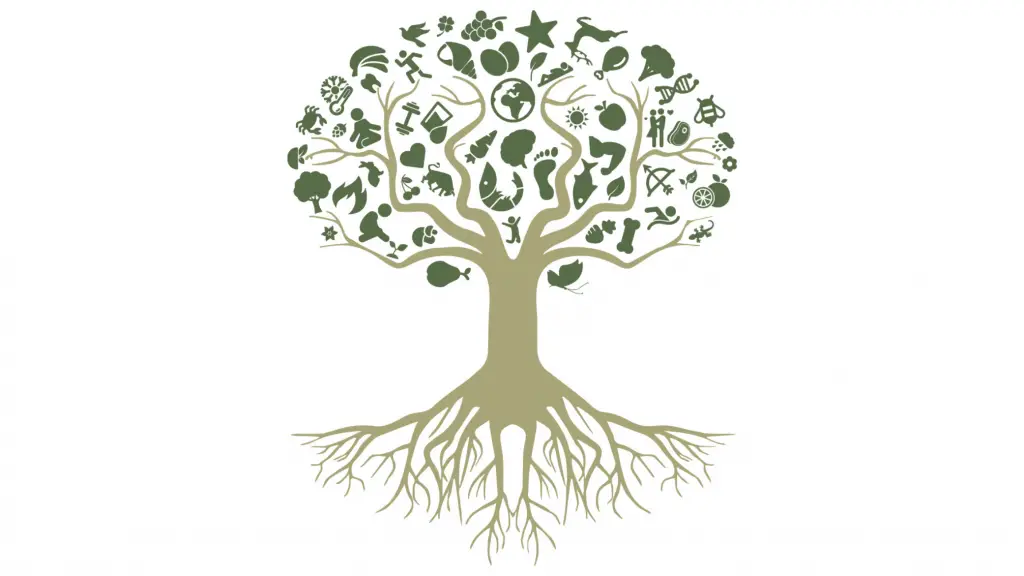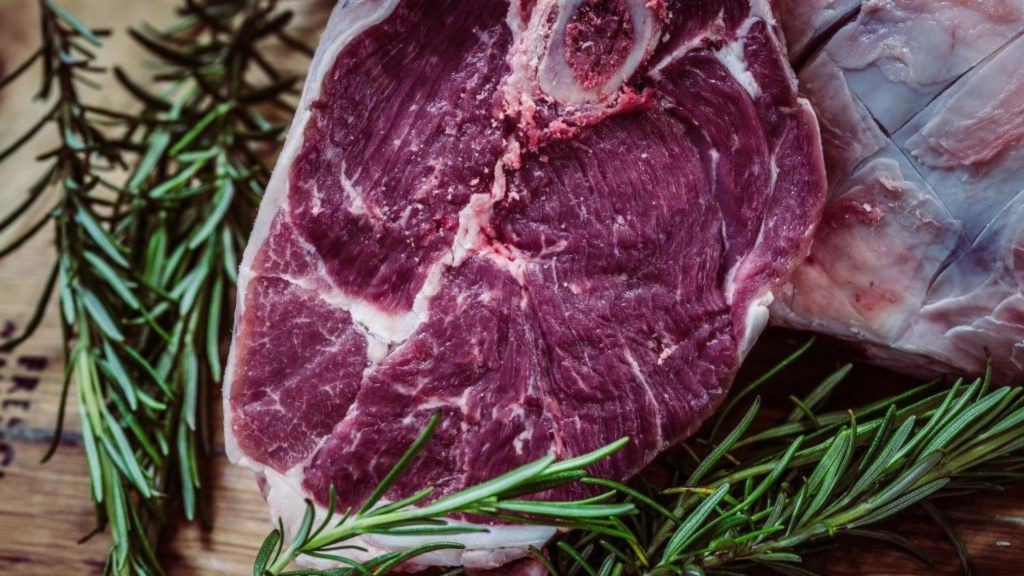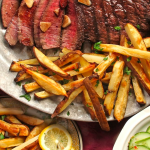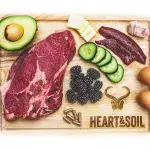On an ancestral diet, you avoid processed food and eat what your body is designed to eat — just like our ancestors did.
The ancestral diet is similar to a nose-to-tail carnivore diet but can include some seasonal fruits and vegetables in small amounts. An extreme version of the ancestral diet is currently popularized by the fitness influencer Liver King.
Here we explain what a true ancestral diet is, analyze the science behind it, and give practical tips for improving your diet and lifestyle so you can reclaim optimal health and thrive in the modern world.
TABLE OF CONTENTS
What is the Ancestral Diet?
The ancestral diet centers around eating unrefined, unprocessed, whole food — just like our primal ancestors. The ancestral diet is an umbrella term that describes ways of eating that are based on unprocessed, organic, natural, and wholesome foods that you can harvest from the oceans, rivers, lakes, and earth by fishing, gathering, and hunting.
Compared to our primal ancestors, our genome hasn’t changed a lot. Thus, genetically, modern humans are adapted to the same diet and foods our ancestors ate.
There are many advantages to an ancestral diet, from weight loss to decreased inflammation, reversal of metabolic syndrome, and better gut health. The diet includes organic, unprocessed, natural, and wholesome foods such as fruits, vegetables, meats, nuts, and seeds. You should avoid all heavily processed, industrial foods.

Dr Weston A. Price and the Ancestral Diet
Dr. Weston A. Price was a practicing dentist who traveled the world to study the diets of traditional people and the effect they had on their health. He observed both Western and Eastern traditional cultures.
From Native Americans living in the Colorado Rockies to the Aborigines of Australia, he observed the behavior of various communities. In these populations, he found out that there was an absence of tooth decay and cavities, wide, attractive smiles with straight teeth, along with a marked absence of the ‘diseases of civilization’ such as diabetes, osteoporosis, cancer, heart and autoimmune diseases.
He compared the traditional versus modernized people of each culture and concluded that nutrition was the answer to several problems that modern humans face. Below, we can see the levels of dental disease amongst traditional people compared to the modernized members of the same culture:
| Culture | % of Traditional People Affected by Cavities | % of Modernized People Affected by Cavities (1930) |
| Swiss | 4.6 | 29.8 |
| Native North American | 0.16 | 21.5 |
| Inuit | 0.09 | 13 |
| Gaelic | 1.2 | 30 |
| Australian Aborigines | 0 | 70.9 |
| Seminole Indians | 4 | 40 |
| Africans | 0.2 | 6.8 |
| Malays | 0.09 | 20.6 |
Dental disease increased in all cultures as they adopted a modern diet, and abandoned their ancestral eating ways.
Popular Diets based on the Ancestral Lifestyle
There are various popular diets that follow the ancestral lifestyle, such as carnivore, paleo, and keto. The true ancestral diet is in between the carnivore and paleo diets because it is mostly based on animal foods like the carnivore diet, but allows some seasonal fruits and vegetables.
However, unlike the paleo diet, a true ancestral diet avoids vegetables that are high in anti-nutrients that can cause digestive issues for people, The paleo diet focuses on those foods that were present in the Paleolithic era about 2.5 million years ago, before modern agriculture.
This means that dairy and grains are excluded on the paleo diet. On the other hand, the ancestral diet focuses on cultural, local, and seasonal food that varies depending on the part of the world you reside in, and can include some dairy and fermented foods.
| Ancestral | Carnivore | Paleo | Keto | |
|---|---|---|---|---|
| Summary | 90% hunting foods, 10% gathering | 100% animal products | 40% hunting, 60% gathering foods | Carb restriction to achieve ketosis |
| Protein | Flexible | High | High | Medium |
| Fat | Flexible | High | Medium | High |
| Carbs | Flexible | Zero | 50h to 100g | Up to 50g |
| Dairy | Yes | Yes | No | Yes |
| Organ Meat | Lots | Lots | Some | Some |
| Vegetables / Fruit | Seasonal, low in anti-nutrients | None | Lots of both | Vegetables but no fruit |
| Nuts / seeds | In moderation | None | Yes | Yes |
| Best for: | Optimal health | Healing health conditions | Beginners | Losing weight |
The Standard American Diet and its Harmful Effects on Human Health
The Standard American Diet goes against the dietary history of the human race. Humans didn’t eat processed carbohydrates for millions of years.
Very early humans had a plant-based gatherer diet (hence one argument for veganism), but paleolithic man started to scavenge meat from the kills of other predators. This resulted in a positive change in their digestive system as well as in their neurological system.
Our ancestors gradually built tools for hunting and increased the amount of meat they consumed. The meat-rich diet was high in nutrition and enhanced cognitive abilities. In short, we evolved because we ate meat — and it was responsible for our species thriving.
However, around 10,000 BC, humans learned how to farm. this is when the overall human health started to deteriorate.
They started to suffer from mineral disorders like osteoporosis and rickets. Moreover, there were indications of mineral and vitamin deficiencies, an increase in infectious diseases, an increase in infant mortality rate, and a reduction in average life span. And things have gotten a lot worse since then.
According to the NHANES 2017-2018 data, the average modern American gets almost 58% of their calories from dangerous highly-processed foods.
These dietary choices are harmful to our bodies — which is why so many people suffer from chronic health issues. Eating lots of grains and carbs raises blood sugar and glycation rate, which causes inflammation that is responsible for many diseases like:
- Heart Disease: Consuming refined carbs starts a domino effect in which inflammation and glycation injure the blood vessels. As the vessels lose their suppleness, the result is high blood pressure and atherosclerosis
- Diabetes: Increased refined carb intake causes Type II Diabetes. Over 34 million Americans suffer from diabetes according to the CDC
- Cancer: Carbs provide cancer cells the fuel they need to grow. Inflammation also plays a role in cancer metastasis and tumor development
We need to return to our ancestral diet not just for our health, but to avoid disease.
The Liver King & The Ancestral Diet

The Liver King is a fitness influencer famous for his ancestral lifestyle, intense workouts, and raw organ meat diet, which he has been following for over 20 years. The Liver king consumes over a pound of raw liver daily.
According to his website, he typically eats food like wild-caught fish eggs, organ meats, muscle meat from pasture-raised, grass-fed animals, bone broth, cheese, full-fat milk, and fermented veggies. He cooks his meals with raw butter, lard, and tallow to increase his consumption of fat. He doesn’t keep a count of the macros or calories. His entire family follows the ancestral lifestyle and eats a nose-to-tail, nutrient-dense diet.
Although we’re big fans of Liver King, his diet is an extreme version of the ancestral diet designed for athletic performance and exaggerated for social media. For example, he eats more organ meat than is recommended (twice a week is sufficient, not daily), and disregards almost all vegetables and fruit.
To follow a practical ancestral diet, you can take inspiration from Liver King and his principles, and base your diet around animal products and nutrient-dense organ meats in appropriate amounts. Most people can include locally-grown seasonal vegetables and fruits without suffering negative digestive consequences.
Ancestral Nutrition: How to Eat Like Your Ancestors
Now that we know what the Ancestral diet and lifestyle are, let’s see what food our ancestors ate, and how we can follow their diet.
To follow an ancestral diet, eat these foods:
Animal Products

Our hunter-gatherer ancestors got almost 45 to 65% of their daily energy requirement from animal products. Scientists believe that the increase in the size of our ancestor’s brains and reduction in the gastrointestinal tract was due to eating muscle-meat and animal-based foods.
Without the nutrients and calories provided by meat, the human brain would not have evolved to its present-day form. By eating healthy fats, bone marrow, organ meat, and muscle meat, our ancestors were able to fuel their brains.
Summary: Eat as much organic red meat, poultry, fish, and shellfish as you want. If you tolerate them well, add lots of eggs and raw milk. if you have problems with these, introduce them slowly.
Organ meats (Nose to tail)
When Dr Price was studying different hunter-gatherer societies, their diets, and the effects of their diet on their health, he found that they didn’t let any part of the animal go to waste.
Nose-to-tail eating gives you more nutrition than just muscle meat. When meat, skin, and cartilage are consumed together, they synergize. The methionine present in lean meat works with the choline, glycine, and B vitamins from the organ meats, bone broth, and connective tissues to provide metabolic benefits.
When we consume bone broth, we get glycine, gelatin, collagen, and minerals. Using animal fat to cook our meals helps the body in absorbing fat-soluble vitamins such as K, E, D, and A.
Summary: Consume the whole list of organ meats available, from liver to heart.
Seasonal Fruits & Vegetables

There are various benefits of adding small amounts of fruits and vegetables to the diet. However, they should be seasonal. Our ancestors didn’t have access to genetically modified, available-all-through-the-year vegetables and fruits.
If you add fruits to your diet, particularly citrus fruits, you will get important nutrients such as Vitamin C. For example, a 100-g serving of orange contains 46 mg of Vitamin C. Fruits like avocado and banana are good sources of folate as well.
Eating fruit helps you with problems such as diarrhea, and hyperthyroidism. The essential nutrients in fruits are crucial for a healthy microbiome. However, there are a few reasons why you shouldn’t consume a lot of fruit and vegetables.
Even though vegetables are full of nutrients, they contain natural pesticides in them. Brassica vegetables such as broccoli, cabbage, turnip, kale, and brussel sprouts contain anti-nutrients known as goitrogens, and some plants also contain salicylates and oxalates. These all disrupt your digestion and cause inflammation.
This doesn’t even include all the industrial fertilizers and pesticides used in industrial agirculture.
In short, most vegetables want to keep growing and don’t want to be eaten, so they defend themselves. However, fruits want to be eaten and spread their seeds, so they are sweet and easy to digest.
Summary: Buy local, seasonal vegetables like carrots and sweet potatoes, and fruit like avocados and bananas to diversify your gut health, but eat them in moderation.
Fermented Foods
Our ancestors fermented vegetables and dairy to make them easier to digest. Fermented foods like kefir, cheese, yogurt, sourdough bread, and kombucha are popular worldwide, and have numerous health benefits.
The probiotics that are created during fermentation help in alleviating digestive issues such as irritable bowel syndrome and restore the balance of friendly gut bacteria. A study showed that consuming yogurt-like fermented milk improved IBS symptoms that include stool frequency and bloating.
Moreover, fermented foods give a boost to your immune system and lower the risk of infections such as the common cold. During fermentation, nutrients in the food are broken down, which makes it easy for you to digest them.
For instance, lactose is broken down into glucose and galactose during fermentation. Thus, those who are lactose intolerant can easily eat fermented dairy products like yogurt and kefir. All the antinutrients like lectins and phytates are broken down during fermentation.
Summary: Eat locally-produced fermented foods in moderation, and listen to your gut.
Foods to Avoid
Our ancestors didn’t consume refined grains, sugar, soy products, artificial colors, or anything processed on an industrial scale. When you are following an ancestral diet, you need to remember one cardinal rule — nothing processed should be a part of your diet.
Here are the foods that should be avoided in an ancestral diet.
- Refined Sugar
- Refined Grains
- Seed Oils such as Soybean and Canola
- Genetically Modified Foods
- Additives
- Preservatives
Apart from the above-mentioned food, you need to limit the consumption of these items as well.
- Alcoholic Products
- Fat-Free/Low-Fat products
- Processed Wheat Products
Benefits of Ancestral Eating

There are numerous medical and health benefits of an ancestral diet, such as weight loss and improved gut health.
Increased Life Span
It is a myth that the Paleolithic ancestors only lived till the age of 30. The lower life expectancy in some studies was skewed by the high infant mortality rate.
In reality, anthropologists believe that the life span of hunter-gatherers — if they survived childhood — was up to 78 years. Since they didn’t suffer from chronic diseases, their later years were of a higher quality than many elderly people today.
An ancestral lifestyle along with the advances of modern medicine will help us lead a longer, healthier life.
Weight Loss
Over 1/3 of American adults are obese and overweight.
Ancestral diets such as paleo and carnivore are more satiating, which leads to lower consumption of calories and toweight loss. A research study showed that people who reduced refined grains, processed foods, and sugar in their diet for over 12 months lost weight, regardless of the macros they consumed.
Reduced Inflammation
Refined grains, sugars, and seed oils result in chronic inflammation, which drives chronic diseases such as cardiovascular disease and diabetes. In contrast to this, ancestral diets eliminate harmful foods and focus on whole, nutrient-dense foods that decrease inflammation and reduce the risk of developing chronic diseases.
The ancestral diet reduces the inflammatory marker C-reactive protein, and improves blood pressure and lipid profiles.
Helps with Metabolic Syndrome
1/3 of adults in the US suffer from metabolic syndrome. It is characterized by the following markers:
- High Blood Pressure
- Elevated Triglycerides
- Elevated Fasting Glucose
- Large Waist
- Low HDL Cholesterol
In various clinical trials, the ancestral diets have outperformed other diets that are recommended by organizations such as American Heart Association. Various studies have shown that an ancestral diet improves body weight, blood pressure, waist circumference, HDL and LDL, and triglycerides.
Improved Gut Health
Gut health — microbiome diversity and gut wall integrity — is linked to overall improved health. People who eat paleo diets have a diverse microbiome similar to traditional populations such as Matses, Hadza, and Inuit.
The ancestral populations who consume both plant and animal foods have better microbial diversity than those who follow an industrial diet of processed food. Carbs such as refined sugars and flours damage your gut microbiome, thus you should stay away from them.
Ancestral Health in the Modern World

The ancestral lifestyle isn’t just about the way you eat — it’s an entire way of living. From the way you sleep to the way you exercise and relax, it is all about making you into a better, healthier version of yourself.
Here’s how you can adopt the ancestral lifestyle and reap its benefits.
Sleep
Our ancestors began and ended their days in accordance with the rising and setting of the sun. This eliminated sleep disorders as well as ‘mid-afternoon slumps’. We recommend that you follow nature’s circadian rhythm, wake up at sunrise, and get early morning sun.
You should regulate your sleeping habits — go to bed and wake up at a particular time every day, and sleep for 9 hours in a dark room. Evidence shows this reduces depression, inflammation, and stress, and improves our cognitive abilities.
Our ancestors slept on the ground — they didn’t sleep on pillow-top mattresses. Moreover, they didn’t use phones before going to bed and didn’t get exposed to harmful artificial light. Exposure to artificial lights disrupts the native sleep/wake cycle by suppressing melatonin.
To combat this, try getting some blue-light blocking glasses to wear at night, and avoid all screens one hour before bed time.
Exercise
On average, modern American adults spend 10 hours daily sitting down. With up to 8 hours of sleep, this comes to a total of 18 hours that we spend in a sedentary state. Our ancestors, on the other hand, were constantly moving
Begin by taking a walk in nature, twice daily. Our ancestors lived a hard life that was full of intense activity. You don’t need to replicate this completely, but some yoga, a short bike ride, or an intense morning workout will yield fantastic results.
During lunchtime, take a brisk walk to get your heart pumping and your blood circulating. Incorporate bodyweight training in your daily routine, particularly essential movements that we humans were designed to do like lifting our own body weight, pull-ups, push-ups, planks, and squats.
Once you’ve mastered the basics, try joining a Crossfit class or other functional fitness activity. Weight training isn’t only about building muscle mass — your posture becomes better and your sleep improves, and it helps you improve bone density, lose weight, boost your metabolism, and lower inflammation.
Grounding
Our ancestors were constantly connected with nature, and walked barefoot on the fertile ground. All other living things — fish, mammals, and even trees — remain connected with the earth 24/7. Our planet gives off a powerful, healing energy.
We were designed to achieve an electrical balance in our bodies. When positive electrons accumulate, we suffer from inflammation. The earth has a negative charge, so when we walk barefoot on the ground, we neutralize the positive electrons. Since the advent of elevated beds, flooring, and shoes, we have lost the connection with Earth and its electrical field.
Earthing — or walking barefoot — restores the natural electrical state of the body and helps improve overall health. Simply take your shoes off and walk barefoot for some time every day.
Light
Lack of sunlight and particularly Vitamin D is the root cause of anxiety, fatigue, and depression. Over 40% of Americans are deficient in Vit D. By exposing ourselves to the Sun, we can maximize the amount of Vitamin D we intake. Vitamin D reduces depression, fights diseases, and helps with weight loss.
Biohacks like red light therapy show promise in the treatment of redness, scars, aging, wrinkles, and a lot more.
Social Connection
Since the beginning of our species, humans have lived together in the form of communities and tribes. Our ancestors spent their entire lives protecting their tribe and providing for them. They risked their lives to keep them safe and taught the next generation to do the same.
These responsibilities created powerful bonds between them and built a strong social connection. In the modern world, this doesn’t happen often. We have security guards, we send our children to schools, and families live far away from each other.
A sense of community and society is what keeps us humans going spiritually. You can start by reaching out to your family and friends — send them a text, give them a call, find some time and meet them in person.
Conclusion: A Diet Based on Ancestry and Science

The ancestral diet and lifestyle is a holistic way of living your life, which rejuvenates your physical and mental health. It focuses on increasing the consumption of whole, nutrient-dense foods, and reducing the consumption of highly-processed foods.
Such a diet reduces your carb intake and increases the consumption of fresh meat, seafood, and natural, healthy fats. It will lower your insulin levels and blood sugar, and help you lose weight to look and feel your best. There will be a reduced likelihood of heart disease, cancer, diabetes, and numerous other modern health issues.
Here are a few key takeaways that will get you started with the ancestral way of living.
- Eat mostly animal-based products
- Eat nose-to-tail
- Avoid refined grains, sugars, and processed foods.
- Add organic, local, and seasonal vegetables and fruits to your diet
- Maintain a proper sleep cycle
- Exercise, spend time in the sunlight, and build a strong social connection with your tribe









Leave a Reply